Theory of Counseling and Psychotherapy
VerifiedAdded on 2022/11/25
|15
|4430
|348
AI Summary
This essay discusses the historical aspects and concepts of person-centered therapy and choice theory in counseling and psychotherapy. It explores the theories' underpinnings, such as self-actualization and conditions of worth, and examines the role of internal control psychology. The essay also explores the integration of person-centered therapy, reality therapy/choice theory, and multicultural counseling and therapy into a functional model.
Contribute Materials
Your contribution can guide someone’s learning journey. Share your
documents today.
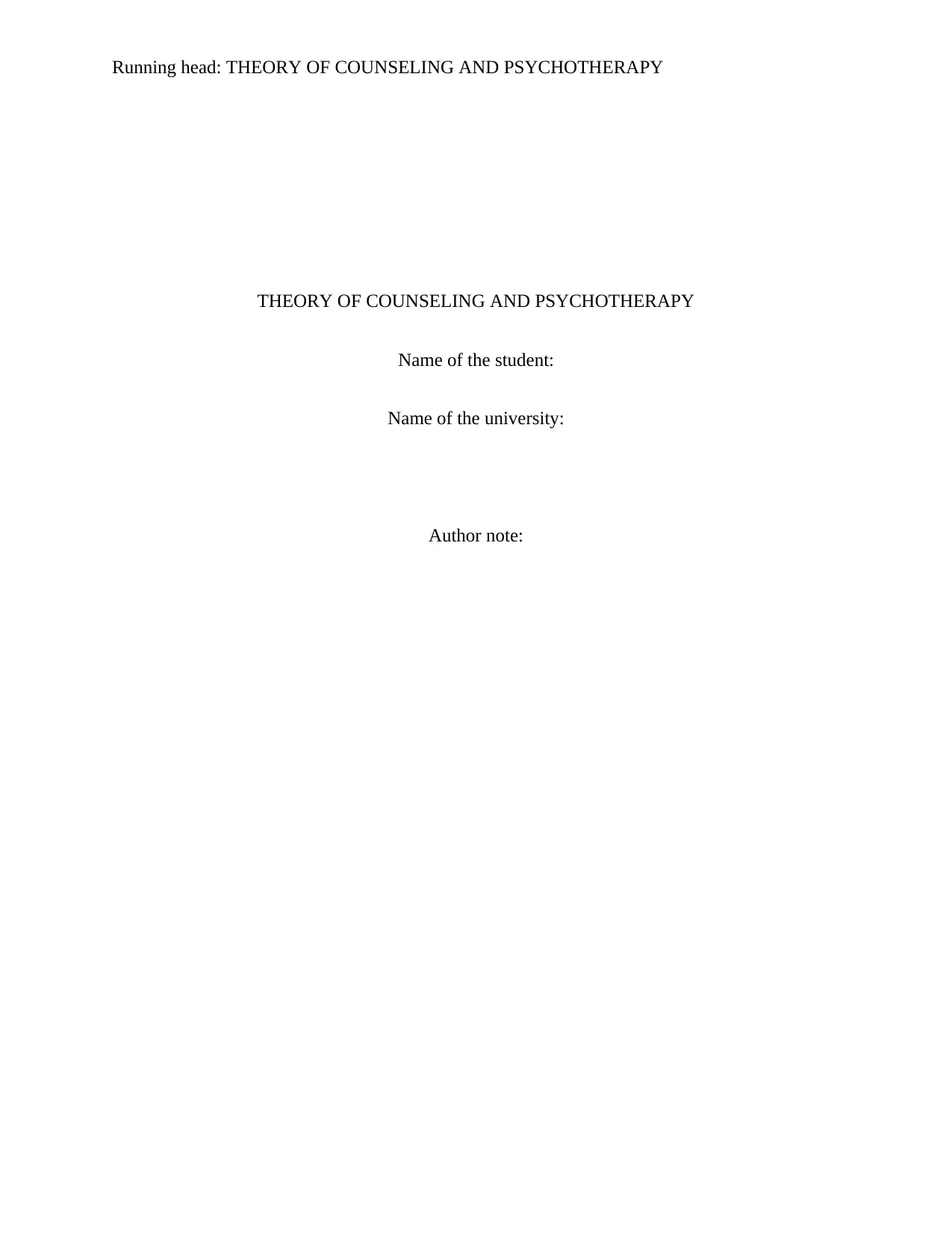
Running head: THEORY OF COUNSELING AND PSYCHOTHERAPY
THEORY OF COUNSELING AND PSYCHOTHERAPY
Name of the student:
Name of the university:
Author note:
THEORY OF COUNSELING AND PSYCHOTHERAPY
Name of the student:
Name of the university:
Author note:
Secure Best Marks with AI Grader
Need help grading? Try our AI Grader for instant feedback on your assignments.
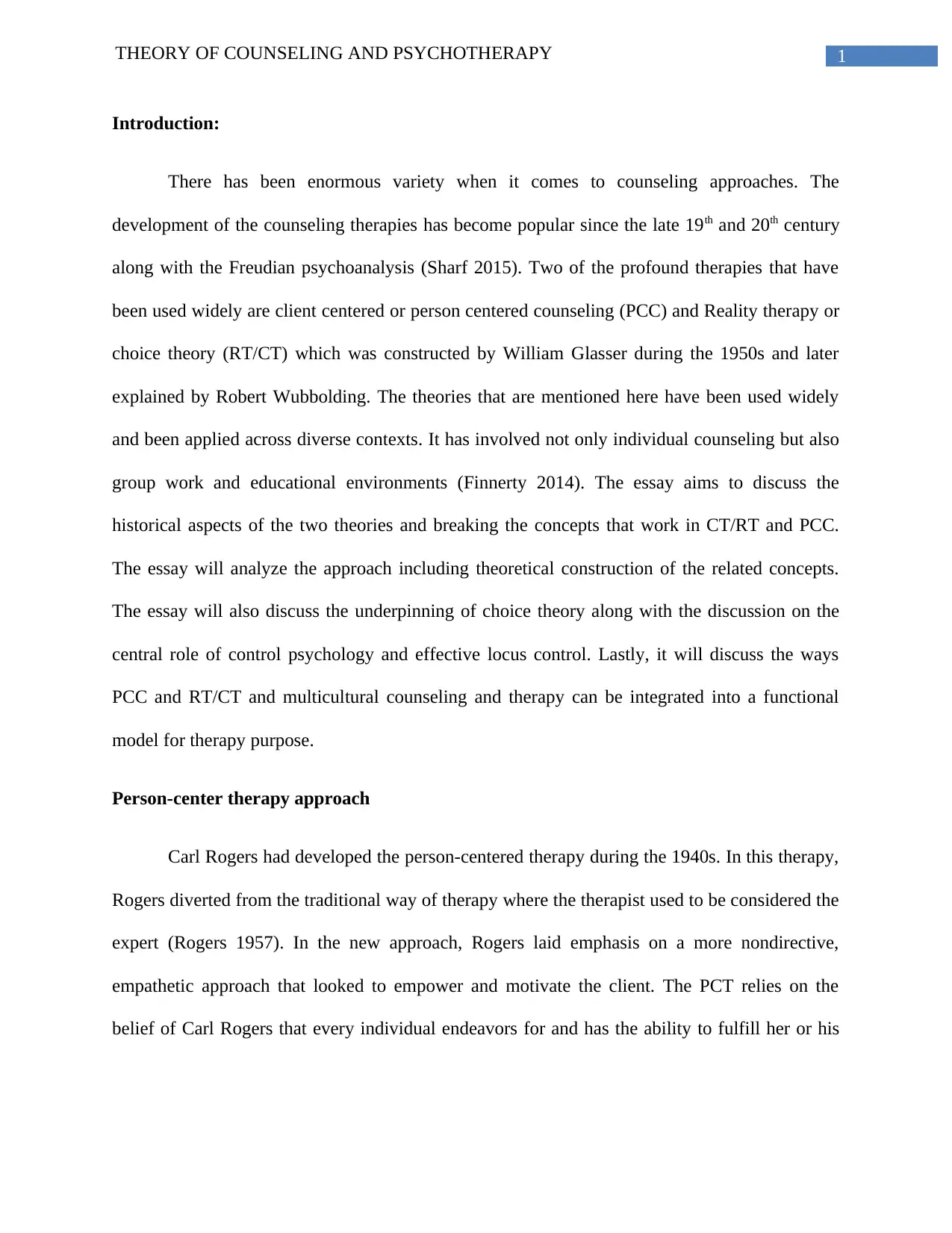
1THEORY OF COUNSELING AND PSYCHOTHERAPY
Introduction:
There has been enormous variety when it comes to counseling approaches. The
development of the counseling therapies has become popular since the late 19th and 20th century
along with the Freudian psychoanalysis (Sharf 2015). Two of the profound therapies that have
been used widely are client centered or person centered counseling (PCC) and Reality therapy or
choice theory (RT/CT) which was constructed by William Glasser during the 1950s and later
explained by Robert Wubbolding. The theories that are mentioned here have been used widely
and been applied across diverse contexts. It has involved not only individual counseling but also
group work and educational environments (Finnerty 2014). The essay aims to discuss the
historical aspects of the two theories and breaking the concepts that work in CT/RT and PCC.
The essay will analyze the approach including theoretical construction of the related concepts.
The essay will also discuss the underpinning of choice theory along with the discussion on the
central role of control psychology and effective locus control. Lastly, it will discuss the ways
PCC and RT/CT and multicultural counseling and therapy can be integrated into a functional
model for therapy purpose.
Person-center therapy approach
Carl Rogers had developed the person-centered therapy during the 1940s. In this therapy,
Rogers diverted from the traditional way of therapy where the therapist used to be considered the
expert (Rogers 1957). In the new approach, Rogers laid emphasis on a more nondirective,
empathetic approach that looked to empower and motivate the client. The PCT relies on the
belief of Carl Rogers that every individual endeavors for and has the ability to fulfill her or his
Introduction:
There has been enormous variety when it comes to counseling approaches. The
development of the counseling therapies has become popular since the late 19th and 20th century
along with the Freudian psychoanalysis (Sharf 2015). Two of the profound therapies that have
been used widely are client centered or person centered counseling (PCC) and Reality therapy or
choice theory (RT/CT) which was constructed by William Glasser during the 1950s and later
explained by Robert Wubbolding. The theories that are mentioned here have been used widely
and been applied across diverse contexts. It has involved not only individual counseling but also
group work and educational environments (Finnerty 2014). The essay aims to discuss the
historical aspects of the two theories and breaking the concepts that work in CT/RT and PCC.
The essay will analyze the approach including theoretical construction of the related concepts.
The essay will also discuss the underpinning of choice theory along with the discussion on the
central role of control psychology and effective locus control. Lastly, it will discuss the ways
PCC and RT/CT and multicultural counseling and therapy can be integrated into a functional
model for therapy purpose.
Person-center therapy approach
Carl Rogers had developed the person-centered therapy during the 1940s. In this therapy,
Rogers diverted from the traditional way of therapy where the therapist used to be considered the
expert (Rogers 1957). In the new approach, Rogers laid emphasis on a more nondirective,
empathetic approach that looked to empower and motivate the client. The PCT relies on the
belief of Carl Rogers that every individual endeavors for and has the ability to fulfill her or his
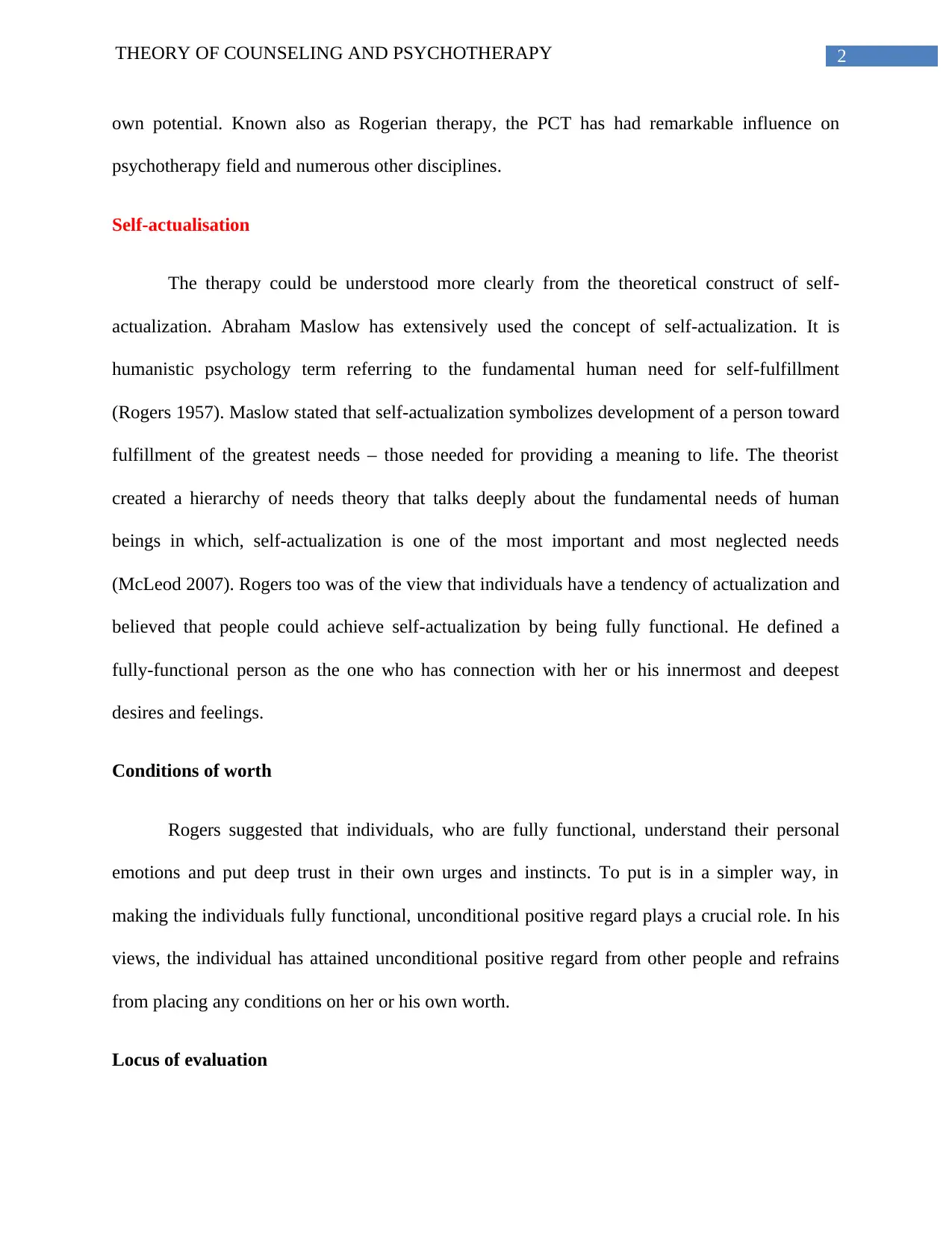
2THEORY OF COUNSELING AND PSYCHOTHERAPY
own potential. Known also as Rogerian therapy, the PCT has had remarkable influence on
psychotherapy field and numerous other disciplines.
Self-actualisation
The therapy could be understood more clearly from the theoretical construct of self-
actualization. Abraham Maslow has extensively used the concept of self-actualization. It is
humanistic psychology term referring to the fundamental human need for self-fulfillment
(Rogers 1957). Maslow stated that self-actualization symbolizes development of a person toward
fulfillment of the greatest needs – those needed for providing a meaning to life. The theorist
created a hierarchy of needs theory that talks deeply about the fundamental needs of human
beings in which, self-actualization is one of the most important and most neglected needs
(McLeod 2007). Rogers too was of the view that individuals have a tendency of actualization and
believed that people could achieve self-actualization by being fully functional. He defined a
fully-functional person as the one who has connection with her or his innermost and deepest
desires and feelings.
Conditions of worth
Rogers suggested that individuals, who are fully functional, understand their personal
emotions and put deep trust in their own urges and instincts. To put is in a simpler way, in
making the individuals fully functional, unconditional positive regard plays a crucial role. In his
views, the individual has attained unconditional positive regard from other people and refrains
from placing any conditions on her or his own worth.
Locus of evaluation
own potential. Known also as Rogerian therapy, the PCT has had remarkable influence on
psychotherapy field and numerous other disciplines.
Self-actualisation
The therapy could be understood more clearly from the theoretical construct of self-
actualization. Abraham Maslow has extensively used the concept of self-actualization. It is
humanistic psychology term referring to the fundamental human need for self-fulfillment
(Rogers 1957). Maslow stated that self-actualization symbolizes development of a person toward
fulfillment of the greatest needs – those needed for providing a meaning to life. The theorist
created a hierarchy of needs theory that talks deeply about the fundamental needs of human
beings in which, self-actualization is one of the most important and most neglected needs
(McLeod 2007). Rogers too was of the view that individuals have a tendency of actualization and
believed that people could achieve self-actualization by being fully functional. He defined a
fully-functional person as the one who has connection with her or his innermost and deepest
desires and feelings.
Conditions of worth
Rogers suggested that individuals, who are fully functional, understand their personal
emotions and put deep trust in their own urges and instincts. To put is in a simpler way, in
making the individuals fully functional, unconditional positive regard plays a crucial role. In his
views, the individual has attained unconditional positive regard from other people and refrains
from placing any conditions on her or his own worth.
Locus of evaluation
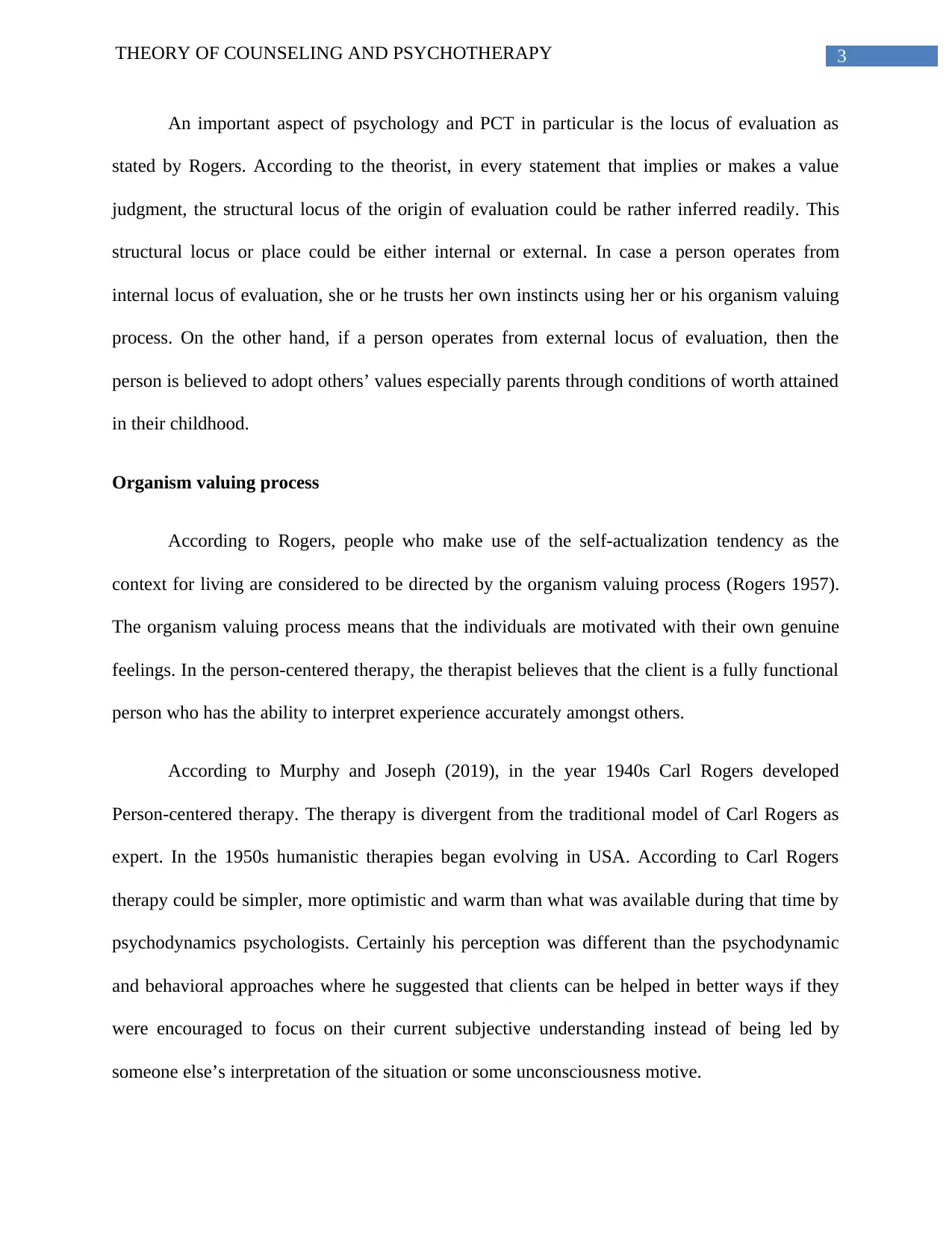
3THEORY OF COUNSELING AND PSYCHOTHERAPY
An important aspect of psychology and PCT in particular is the locus of evaluation as
stated by Rogers. According to the theorist, in every statement that implies or makes a value
judgment, the structural locus of the origin of evaluation could be rather inferred readily. This
structural locus or place could be either internal or external. In case a person operates from
internal locus of evaluation, she or he trusts her own instincts using her or his organism valuing
process. On the other hand, if a person operates from external locus of evaluation, then the
person is believed to adopt others’ values especially parents through conditions of worth attained
in their childhood.
Organism valuing process
According to Rogers, people who make use of the self-actualization tendency as the
context for living are considered to be directed by the organism valuing process (Rogers 1957).
The organism valuing process means that the individuals are motivated with their own genuine
feelings. In the person-centered therapy, the therapist believes that the client is a fully functional
person who has the ability to interpret experience accurately amongst others.
According to Murphy and Joseph (2019), in the year 1940s Carl Rogers developed
Person-centered therapy. The therapy is divergent from the traditional model of Carl Rogers as
expert. In the 1950s humanistic therapies began evolving in USA. According to Carl Rogers
therapy could be simpler, more optimistic and warm than what was available during that time by
psychodynamics psychologists. Certainly his perception was different than the psychodynamic
and behavioral approaches where he suggested that clients can be helped in better ways if they
were encouraged to focus on their current subjective understanding instead of being led by
someone else’s interpretation of the situation or some unconsciousness motive.
An important aspect of psychology and PCT in particular is the locus of evaluation as
stated by Rogers. According to the theorist, in every statement that implies or makes a value
judgment, the structural locus of the origin of evaluation could be rather inferred readily. This
structural locus or place could be either internal or external. In case a person operates from
internal locus of evaluation, she or he trusts her own instincts using her or his organism valuing
process. On the other hand, if a person operates from external locus of evaluation, then the
person is believed to adopt others’ values especially parents through conditions of worth attained
in their childhood.
Organism valuing process
According to Rogers, people who make use of the self-actualization tendency as the
context for living are considered to be directed by the organism valuing process (Rogers 1957).
The organism valuing process means that the individuals are motivated with their own genuine
feelings. In the person-centered therapy, the therapist believes that the client is a fully functional
person who has the ability to interpret experience accurately amongst others.
According to Murphy and Joseph (2019), in the year 1940s Carl Rogers developed
Person-centered therapy. The therapy is divergent from the traditional model of Carl Rogers as
expert. In the 1950s humanistic therapies began evolving in USA. According to Carl Rogers
therapy could be simpler, more optimistic and warm than what was available during that time by
psychodynamics psychologists. Certainly his perception was different than the psychodynamic
and behavioral approaches where he suggested that clients can be helped in better ways if they
were encouraged to focus on their current subjective understanding instead of being led by
someone else’s interpretation of the situation or some unconsciousness motive.
Secure Best Marks with AI Grader
Need help grading? Try our AI Grader for instant feedback on your assignments.
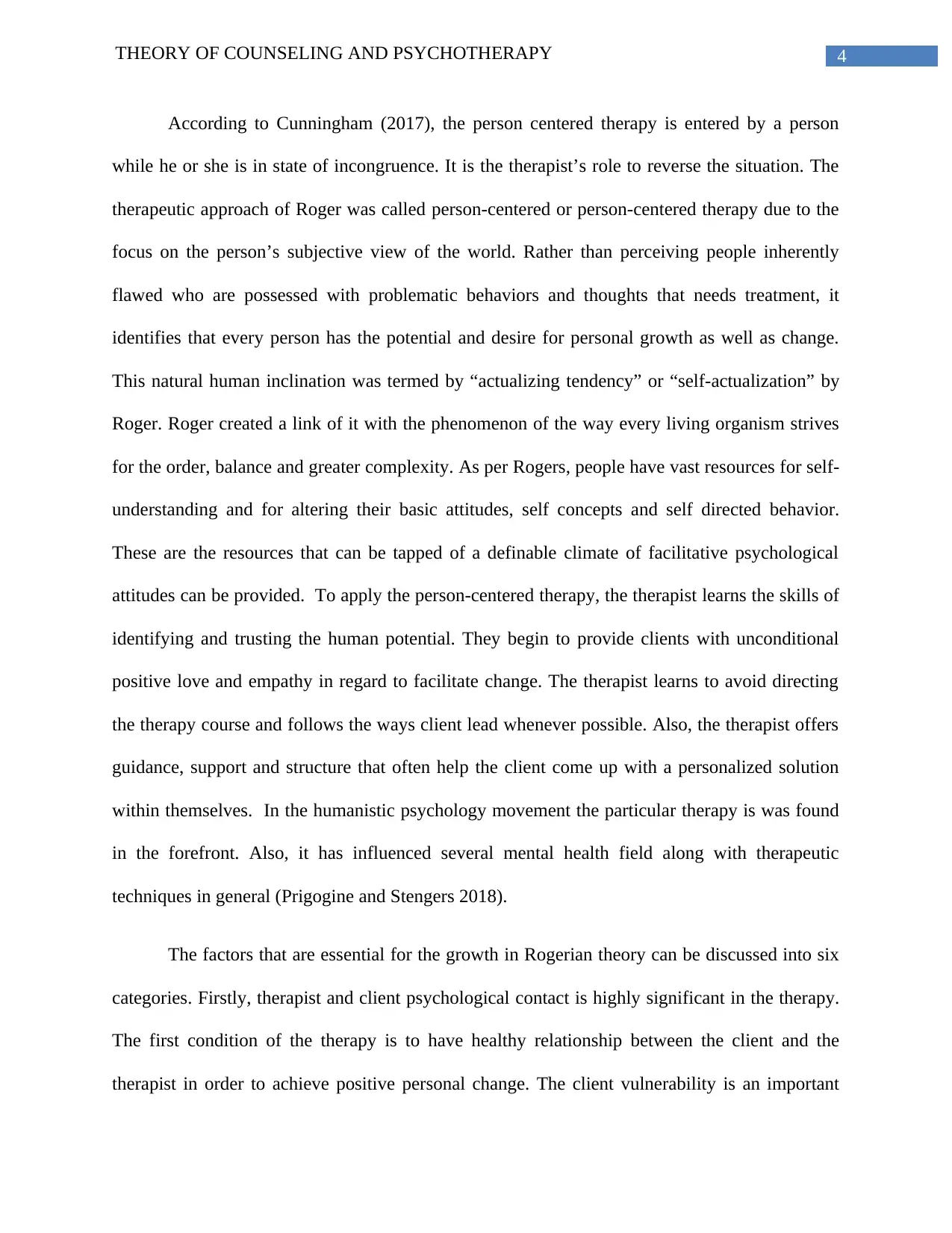
4THEORY OF COUNSELING AND PSYCHOTHERAPY
According to Cunningham (2017), the person centered therapy is entered by a person
while he or she is in state of incongruence. It is the therapist’s role to reverse the situation. The
therapeutic approach of Roger was called person-centered or person-centered therapy due to the
focus on the person’s subjective view of the world. Rather than perceiving people inherently
flawed who are possessed with problematic behaviors and thoughts that needs treatment, it
identifies that every person has the potential and desire for personal growth as well as change.
This natural human inclination was termed by “actualizing tendency” or “self-actualization” by
Roger. Roger created a link of it with the phenomenon of the way every living organism strives
for the order, balance and greater complexity. As per Rogers, people have vast resources for self-
understanding and for altering their basic attitudes, self concepts and self directed behavior.
These are the resources that can be tapped of a definable climate of facilitative psychological
attitudes can be provided. To apply the person-centered therapy, the therapist learns the skills of
identifying and trusting the human potential. They begin to provide clients with unconditional
positive love and empathy in regard to facilitate change. The therapist learns to avoid directing
the therapy course and follows the ways client lead whenever possible. Also, the therapist offers
guidance, support and structure that often help the client come up with a personalized solution
within themselves. In the humanistic psychology movement the particular therapy is was found
in the forefront. Also, it has influenced several mental health field along with therapeutic
techniques in general (Prigogine and Stengers 2018).
The factors that are essential for the growth in Rogerian theory can be discussed into six
categories. Firstly, therapist and client psychological contact is highly significant in the therapy.
The first condition of the therapy is to have healthy relationship between the client and the
therapist in order to achieve positive personal change. The client vulnerability is an important
According to Cunningham (2017), the person centered therapy is entered by a person
while he or she is in state of incongruence. It is the therapist’s role to reverse the situation. The
therapeutic approach of Roger was called person-centered or person-centered therapy due to the
focus on the person’s subjective view of the world. Rather than perceiving people inherently
flawed who are possessed with problematic behaviors and thoughts that needs treatment, it
identifies that every person has the potential and desire for personal growth as well as change.
This natural human inclination was termed by “actualizing tendency” or “self-actualization” by
Roger. Roger created a link of it with the phenomenon of the way every living organism strives
for the order, balance and greater complexity. As per Rogers, people have vast resources for self-
understanding and for altering their basic attitudes, self concepts and self directed behavior.
These are the resources that can be tapped of a definable climate of facilitative psychological
attitudes can be provided. To apply the person-centered therapy, the therapist learns the skills of
identifying and trusting the human potential. They begin to provide clients with unconditional
positive love and empathy in regard to facilitate change. The therapist learns to avoid directing
the therapy course and follows the ways client lead whenever possible. Also, the therapist offers
guidance, support and structure that often help the client come up with a personalized solution
within themselves. In the humanistic psychology movement the particular therapy is was found
in the forefront. Also, it has influenced several mental health field along with therapeutic
techniques in general (Prigogine and Stengers 2018).
The factors that are essential for the growth in Rogerian theory can be discussed into six
categories. Firstly, therapist and client psychological contact is highly significant in the therapy.
The first condition of the therapy is to have healthy relationship between the client and the
therapist in order to achieve positive personal change. The client vulnerability is an important
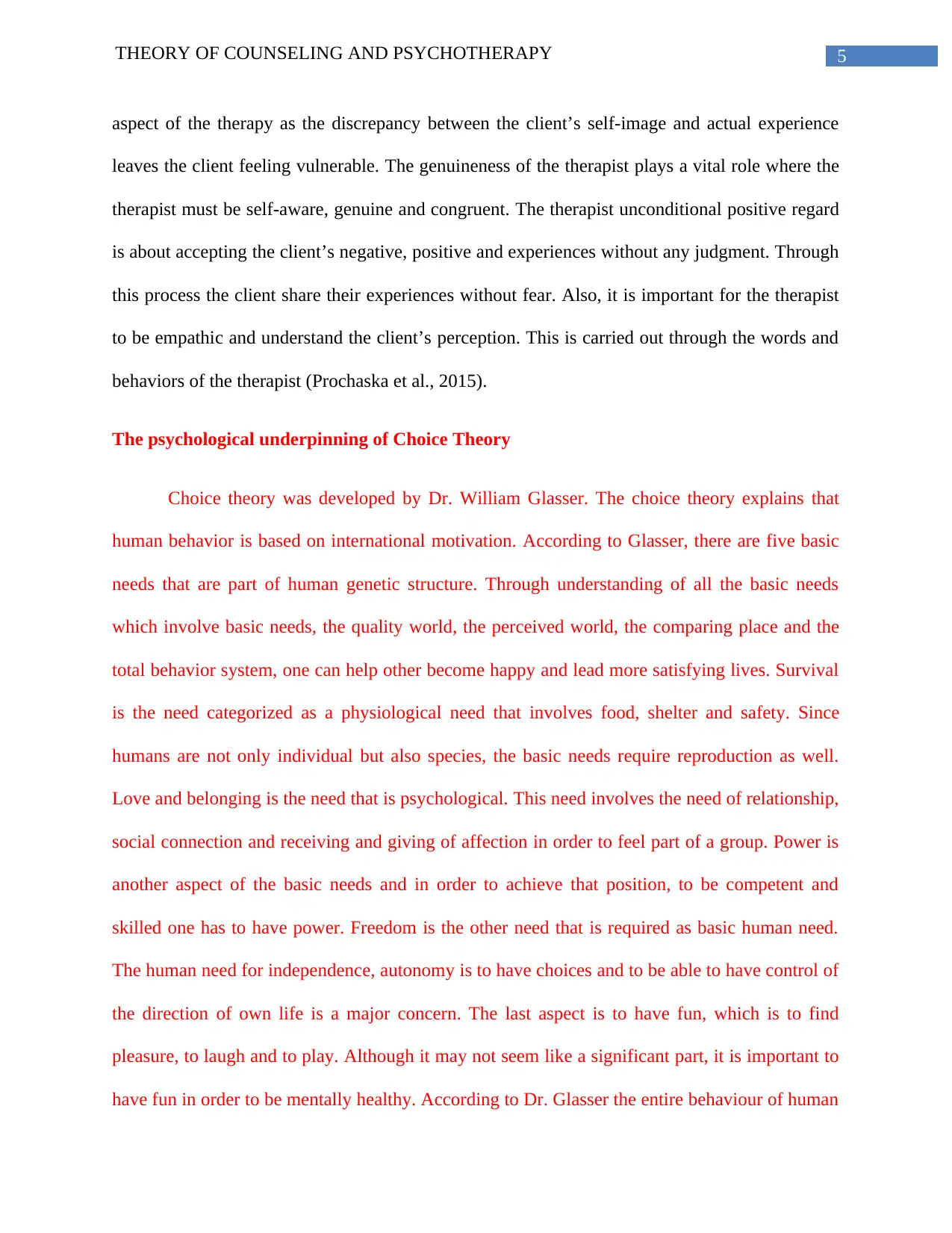
5THEORY OF COUNSELING AND PSYCHOTHERAPY
aspect of the therapy as the discrepancy between the client’s self-image and actual experience
leaves the client feeling vulnerable. The genuineness of the therapist plays a vital role where the
therapist must be self-aware, genuine and congruent. The therapist unconditional positive regard
is about accepting the client’s negative, positive and experiences without any judgment. Through
this process the client share their experiences without fear. Also, it is important for the therapist
to be empathic and understand the client’s perception. This is carried out through the words and
behaviors of the therapist (Prochaska et al., 2015).
The psychological underpinning of Choice Theory
Choice theory was developed by Dr. William Glasser. The choice theory explains that
human behavior is based on international motivation. According to Glasser, there are five basic
needs that are part of human genetic structure. Through understanding of all the basic needs
which involve basic needs, the quality world, the perceived world, the comparing place and the
total behavior system, one can help other become happy and lead more satisfying lives. Survival
is the need categorized as a physiological need that involves food, shelter and safety. Since
humans are not only individual but also species, the basic needs require reproduction as well.
Love and belonging is the need that is psychological. This need involves the need of relationship,
social connection and receiving and giving of affection in order to feel part of a group. Power is
another aspect of the basic needs and in order to achieve that position, to be competent and
skilled one has to have power. Freedom is the other need that is required as basic human need.
The human need for independence, autonomy is to have choices and to be able to have control of
the direction of own life is a major concern. The last aspect is to have fun, which is to find
pleasure, to laugh and to play. Although it may not seem like a significant part, it is important to
have fun in order to be mentally healthy. According to Dr. Glasser the entire behaviour of human
aspect of the therapy as the discrepancy between the client’s self-image and actual experience
leaves the client feeling vulnerable. The genuineness of the therapist plays a vital role where the
therapist must be self-aware, genuine and congruent. The therapist unconditional positive regard
is about accepting the client’s negative, positive and experiences without any judgment. Through
this process the client share their experiences without fear. Also, it is important for the therapist
to be empathic and understand the client’s perception. This is carried out through the words and
behaviors of the therapist (Prochaska et al., 2015).
The psychological underpinning of Choice Theory
Choice theory was developed by Dr. William Glasser. The choice theory explains that
human behavior is based on international motivation. According to Glasser, there are five basic
needs that are part of human genetic structure. Through understanding of all the basic needs
which involve basic needs, the quality world, the perceived world, the comparing place and the
total behavior system, one can help other become happy and lead more satisfying lives. Survival
is the need categorized as a physiological need that involves food, shelter and safety. Since
humans are not only individual but also species, the basic needs require reproduction as well.
Love and belonging is the need that is psychological. This need involves the need of relationship,
social connection and receiving and giving of affection in order to feel part of a group. Power is
another aspect of the basic needs and in order to achieve that position, to be competent and
skilled one has to have power. Freedom is the other need that is required as basic human need.
The human need for independence, autonomy is to have choices and to be able to have control of
the direction of own life is a major concern. The last aspect is to have fun, which is to find
pleasure, to laugh and to play. Although it may not seem like a significant part, it is important to
have fun in order to be mentally healthy. According to Dr. Glasser the entire behaviour of human
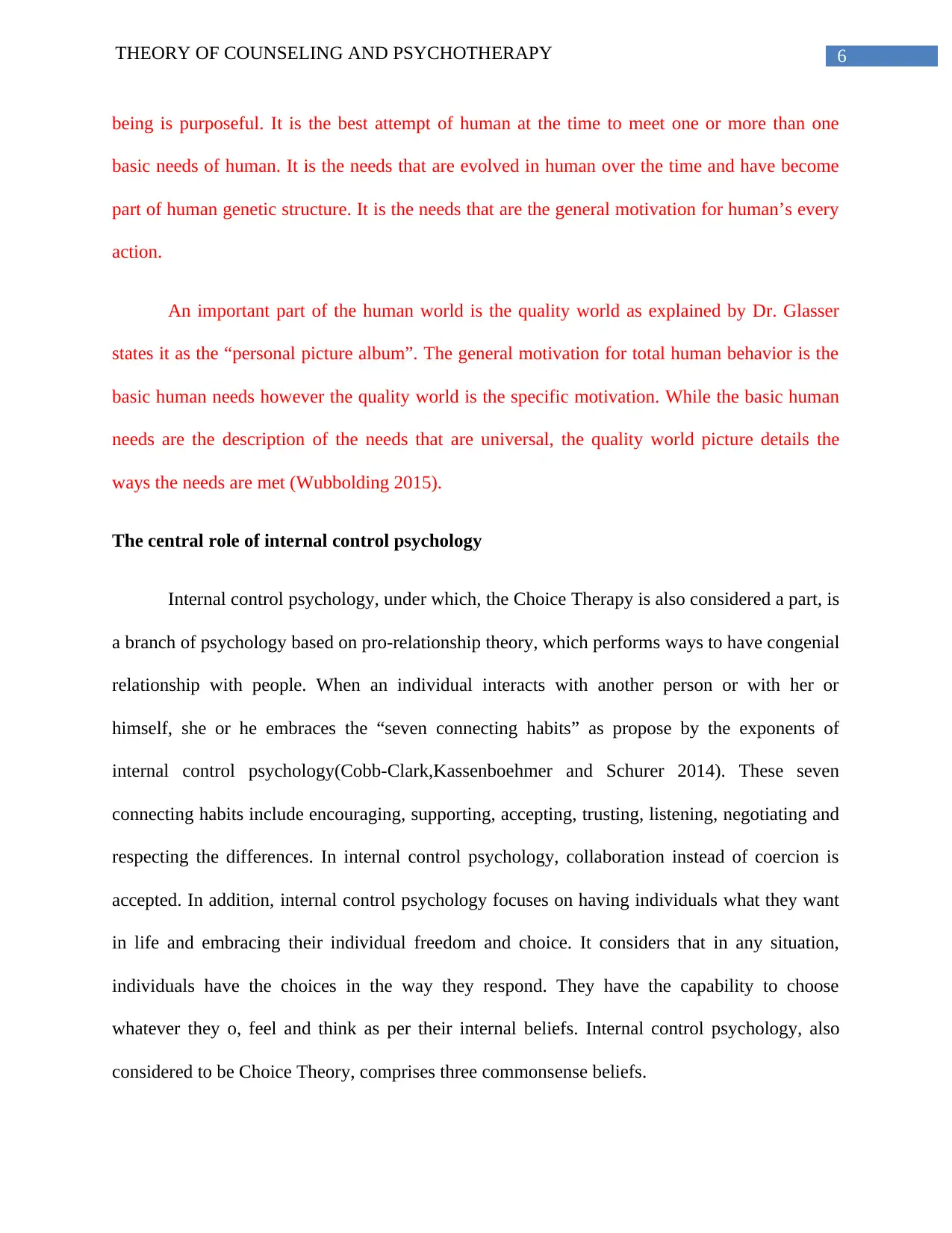
6THEORY OF COUNSELING AND PSYCHOTHERAPY
being is purposeful. It is the best attempt of human at the time to meet one or more than one
basic needs of human. It is the needs that are evolved in human over the time and have become
part of human genetic structure. It is the needs that are the general motivation for human’s every
action.
An important part of the human world is the quality world as explained by Dr. Glasser
states it as the “personal picture album”. The general motivation for total human behavior is the
basic human needs however the quality world is the specific motivation. While the basic human
needs are the description of the needs that are universal, the quality world picture details the
ways the needs are met (Wubbolding 2015).
The central role of internal control psychology
Internal control psychology, under which, the Choice Therapy is also considered a part, is
a branch of psychology based on pro-relationship theory, which performs ways to have congenial
relationship with people. When an individual interacts with another person or with her or
himself, she or he embraces the “seven connecting habits” as propose by the exponents of
internal control psychology(Cobb-Clark,Kassenboehmer and Schurer 2014). These seven
connecting habits include encouraging, supporting, accepting, trusting, listening, negotiating and
respecting the differences. In internal control psychology, collaboration instead of coercion is
accepted. In addition, internal control psychology focuses on having individuals what they want
in life and embracing their individual freedom and choice. It considers that in any situation,
individuals have the choices in the way they respond. They have the capability to choose
whatever they o, feel and think as per their internal beliefs. Internal control psychology, also
considered to be Choice Theory, comprises three commonsense beliefs.
being is purposeful. It is the best attempt of human at the time to meet one or more than one
basic needs of human. It is the needs that are evolved in human over the time and have become
part of human genetic structure. It is the needs that are the general motivation for human’s every
action.
An important part of the human world is the quality world as explained by Dr. Glasser
states it as the “personal picture album”. The general motivation for total human behavior is the
basic human needs however the quality world is the specific motivation. While the basic human
needs are the description of the needs that are universal, the quality world picture details the
ways the needs are met (Wubbolding 2015).
The central role of internal control psychology
Internal control psychology, under which, the Choice Therapy is also considered a part, is
a branch of psychology based on pro-relationship theory, which performs ways to have congenial
relationship with people. When an individual interacts with another person or with her or
himself, she or he embraces the “seven connecting habits” as propose by the exponents of
internal control psychology(Cobb-Clark,Kassenboehmer and Schurer 2014). These seven
connecting habits include encouraging, supporting, accepting, trusting, listening, negotiating and
respecting the differences. In internal control psychology, collaboration instead of coercion is
accepted. In addition, internal control psychology focuses on having individuals what they want
in life and embracing their individual freedom and choice. It considers that in any situation,
individuals have the choices in the way they respond. They have the capability to choose
whatever they o, feel and think as per their internal beliefs. Internal control psychology, also
considered to be Choice Theory, comprises three commonsense beliefs.
Paraphrase This Document
Need a fresh take? Get an instant paraphrase of this document with our AI Paraphraser
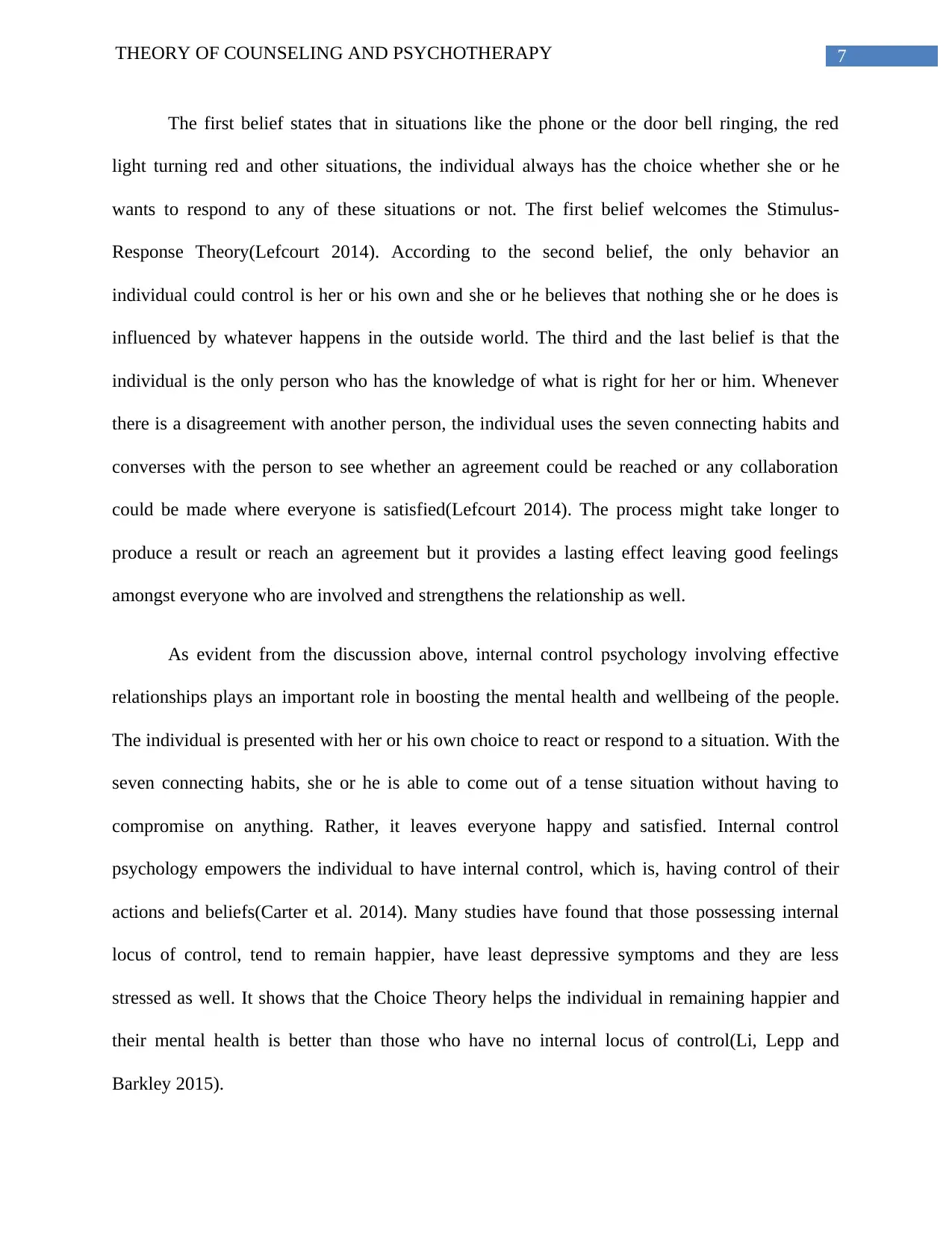
7THEORY OF COUNSELING AND PSYCHOTHERAPY
The first belief states that in situations like the phone or the door bell ringing, the red
light turning red and other situations, the individual always has the choice whether she or he
wants to respond to any of these situations or not. The first belief welcomes the Stimulus-
Response Theory(Lefcourt 2014). According to the second belief, the only behavior an
individual could control is her or his own and she or he believes that nothing she or he does is
influenced by whatever happens in the outside world. The third and the last belief is that the
individual is the only person who has the knowledge of what is right for her or him. Whenever
there is a disagreement with another person, the individual uses the seven connecting habits and
converses with the person to see whether an agreement could be reached or any collaboration
could be made where everyone is satisfied(Lefcourt 2014). The process might take longer to
produce a result or reach an agreement but it provides a lasting effect leaving good feelings
amongst everyone who are involved and strengthens the relationship as well.
As evident from the discussion above, internal control psychology involving effective
relationships plays an important role in boosting the mental health and wellbeing of the people.
The individual is presented with her or his own choice to react or respond to a situation. With the
seven connecting habits, she or he is able to come out of a tense situation without having to
compromise on anything. Rather, it leaves everyone happy and satisfied. Internal control
psychology empowers the individual to have internal control, which is, having control of their
actions and beliefs(Carter et al. 2014). Many studies have found that those possessing internal
locus of control, tend to remain happier, have least depressive symptoms and they are less
stressed as well. It shows that the Choice Theory helps the individual in remaining happier and
their mental health is better than those who have no internal locus of control(Li, Lepp and
Barkley 2015).
The first belief states that in situations like the phone or the door bell ringing, the red
light turning red and other situations, the individual always has the choice whether she or he
wants to respond to any of these situations or not. The first belief welcomes the Stimulus-
Response Theory(Lefcourt 2014). According to the second belief, the only behavior an
individual could control is her or his own and she or he believes that nothing she or he does is
influenced by whatever happens in the outside world. The third and the last belief is that the
individual is the only person who has the knowledge of what is right for her or him. Whenever
there is a disagreement with another person, the individual uses the seven connecting habits and
converses with the person to see whether an agreement could be reached or any collaboration
could be made where everyone is satisfied(Lefcourt 2014). The process might take longer to
produce a result or reach an agreement but it provides a lasting effect leaving good feelings
amongst everyone who are involved and strengthens the relationship as well.
As evident from the discussion above, internal control psychology involving effective
relationships plays an important role in boosting the mental health and wellbeing of the people.
The individual is presented with her or his own choice to react or respond to a situation. With the
seven connecting habits, she or he is able to come out of a tense situation without having to
compromise on anything. Rather, it leaves everyone happy and satisfied. Internal control
psychology empowers the individual to have internal control, which is, having control of their
actions and beliefs(Carter et al. 2014). Many studies have found that those possessing internal
locus of control, tend to remain happier, have least depressive symptoms and they are less
stressed as well. It shows that the Choice Theory helps the individual in remaining happier and
their mental health is better than those who have no internal locus of control(Li, Lepp and
Barkley 2015).
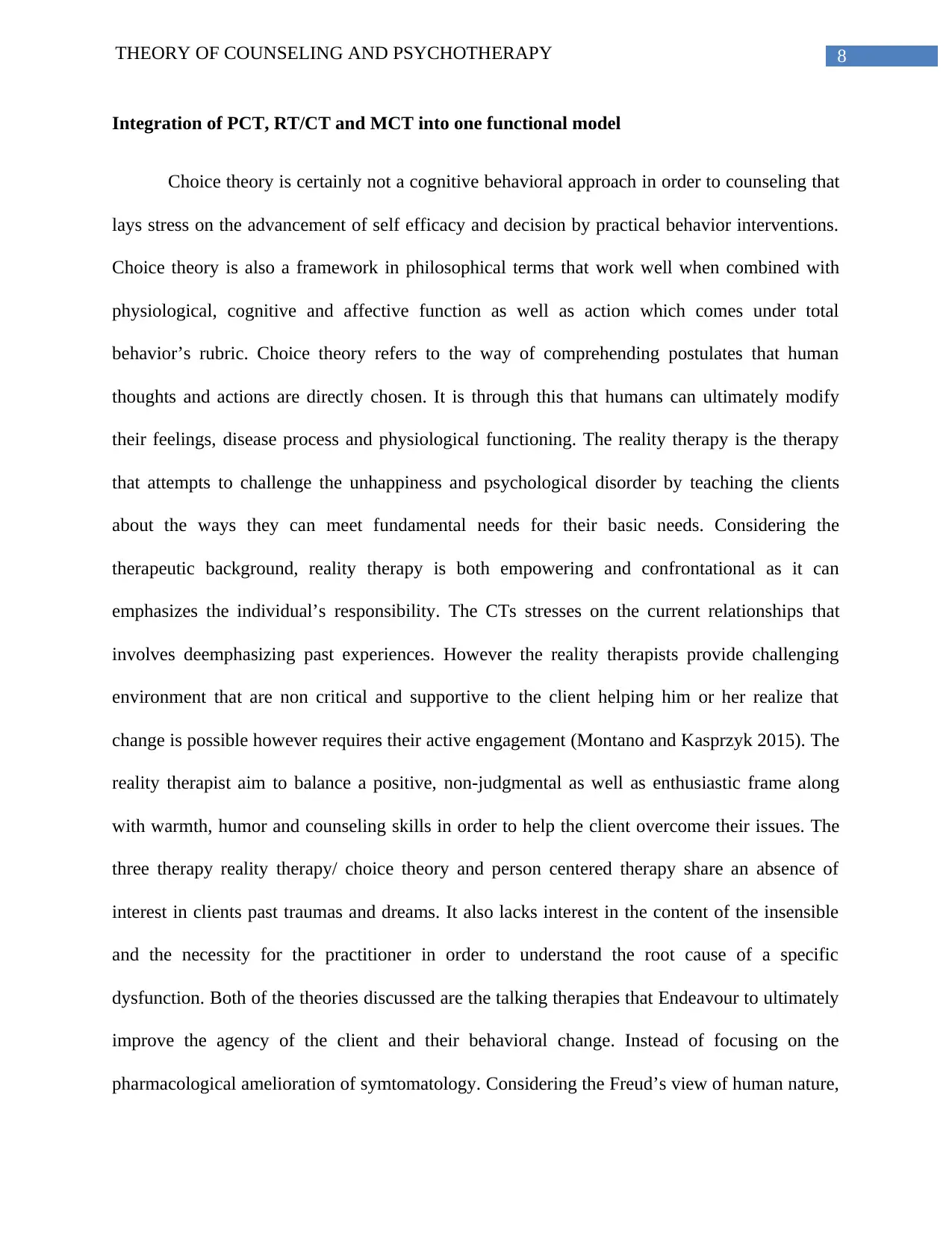
8THEORY OF COUNSELING AND PSYCHOTHERAPY
Integration of PCT, RT/CT and MCT into one functional model
Choice theory is certainly not a cognitive behavioral approach in order to counseling that
lays stress on the advancement of self efficacy and decision by practical behavior interventions.
Choice theory is also a framework in philosophical terms that work well when combined with
physiological, cognitive and affective function as well as action which comes under total
behavior’s rubric. Choice theory refers to the way of comprehending postulates that human
thoughts and actions are directly chosen. It is through this that humans can ultimately modify
their feelings, disease process and physiological functioning. The reality therapy is the therapy
that attempts to challenge the unhappiness and psychological disorder by teaching the clients
about the ways they can meet fundamental needs for their basic needs. Considering the
therapeutic background, reality therapy is both empowering and confrontational as it can
emphasizes the individual’s responsibility. The CTs stresses on the current relationships that
involves deemphasizing past experiences. However the reality therapists provide challenging
environment that are non critical and supportive to the client helping him or her realize that
change is possible however requires their active engagement (Montano and Kasprzyk 2015). The
reality therapist aim to balance a positive, non-judgmental as well as enthusiastic frame along
with warmth, humor and counseling skills in order to help the client overcome their issues. The
three therapy reality therapy/ choice theory and person centered therapy share an absence of
interest in clients past traumas and dreams. It also lacks interest in the content of the insensible
and the necessity for the practitioner in order to understand the root cause of a specific
dysfunction. Both of the theories discussed are the talking therapies that Endeavour to ultimately
improve the agency of the client and their behavioral change. Instead of focusing on the
pharmacological amelioration of symtomatology. Considering the Freud’s view of human nature,
Integration of PCT, RT/CT and MCT into one functional model
Choice theory is certainly not a cognitive behavioral approach in order to counseling that
lays stress on the advancement of self efficacy and decision by practical behavior interventions.
Choice theory is also a framework in philosophical terms that work well when combined with
physiological, cognitive and affective function as well as action which comes under total
behavior’s rubric. Choice theory refers to the way of comprehending postulates that human
thoughts and actions are directly chosen. It is through this that humans can ultimately modify
their feelings, disease process and physiological functioning. The reality therapy is the therapy
that attempts to challenge the unhappiness and psychological disorder by teaching the clients
about the ways they can meet fundamental needs for their basic needs. Considering the
therapeutic background, reality therapy is both empowering and confrontational as it can
emphasizes the individual’s responsibility. The CTs stresses on the current relationships that
involves deemphasizing past experiences. However the reality therapists provide challenging
environment that are non critical and supportive to the client helping him or her realize that
change is possible however requires their active engagement (Montano and Kasprzyk 2015). The
reality therapist aim to balance a positive, non-judgmental as well as enthusiastic frame along
with warmth, humor and counseling skills in order to help the client overcome their issues. The
three therapy reality therapy/ choice theory and person centered therapy share an absence of
interest in clients past traumas and dreams. It also lacks interest in the content of the insensible
and the necessity for the practitioner in order to understand the root cause of a specific
dysfunction. Both of the theories discussed are the talking therapies that Endeavour to ultimately
improve the agency of the client and their behavioral change. Instead of focusing on the
pharmacological amelioration of symtomatology. Considering the Freud’s view of human nature,
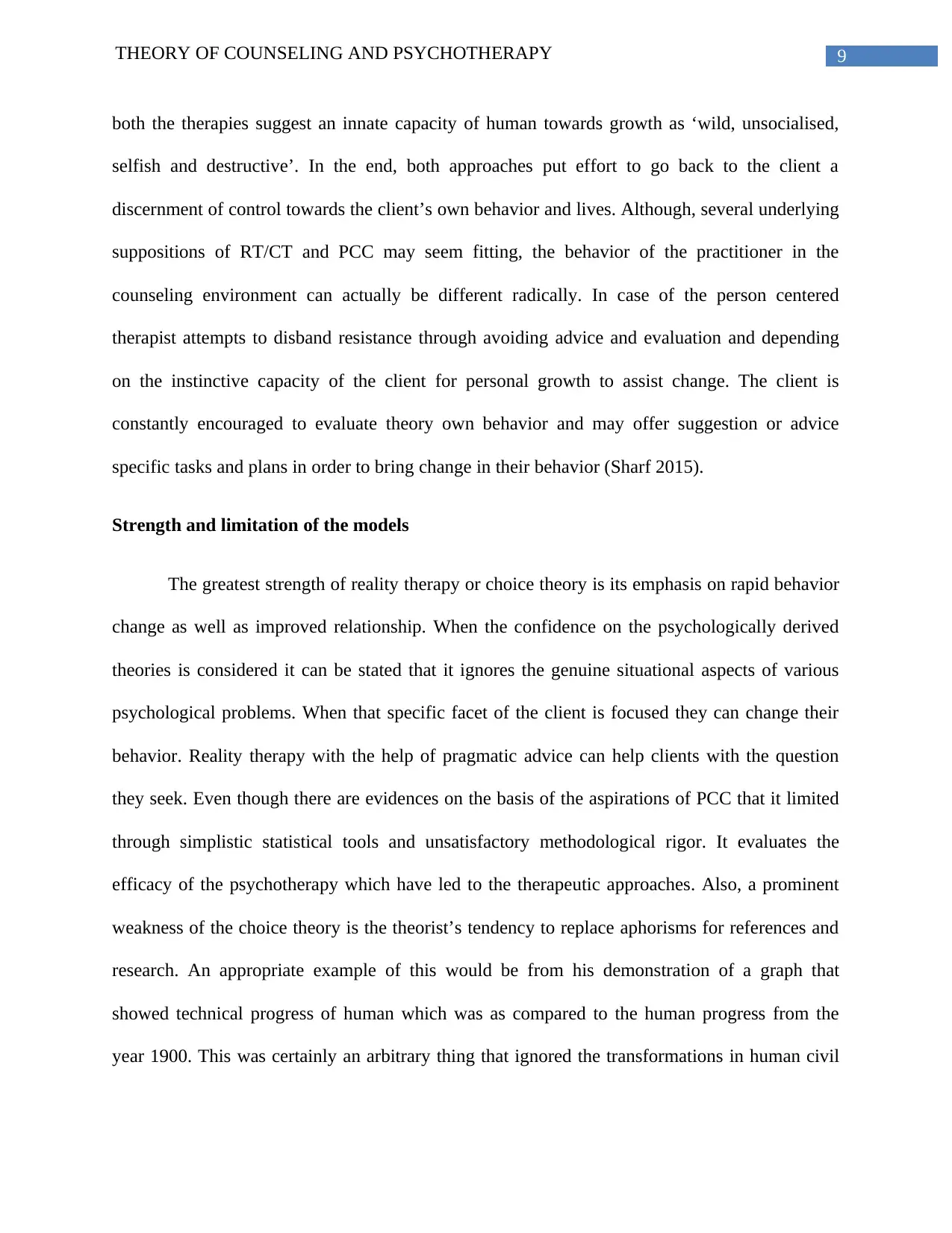
9THEORY OF COUNSELING AND PSYCHOTHERAPY
both the therapies suggest an innate capacity of human towards growth as ‘wild, unsocialised,
selfish and destructive’. In the end, both approaches put effort to go back to the client a
discernment of control towards the client’s own behavior and lives. Although, several underlying
suppositions of RT/CT and PCC may seem fitting, the behavior of the practitioner in the
counseling environment can actually be different radically. In case of the person centered
therapist attempts to disband resistance through avoiding advice and evaluation and depending
on the instinctive capacity of the client for personal growth to assist change. The client is
constantly encouraged to evaluate theory own behavior and may offer suggestion or advice
specific tasks and plans in order to bring change in their behavior (Sharf 2015).
Strength and limitation of the models
The greatest strength of reality therapy or choice theory is its emphasis on rapid behavior
change as well as improved relationship. When the confidence on the psychologically derived
theories is considered it can be stated that it ignores the genuine situational aspects of various
psychological problems. When that specific facet of the client is focused they can change their
behavior. Reality therapy with the help of pragmatic advice can help clients with the question
they seek. Even though there are evidences on the basis of the aspirations of PCC that it limited
through simplistic statistical tools and unsatisfactory methodological rigor. It evaluates the
efficacy of the psychotherapy which have led to the therapeutic approaches. Also, a prominent
weakness of the choice theory is the theorist’s tendency to replace aphorisms for references and
research. An appropriate example of this would be from his demonstration of a graph that
showed technical progress of human which was as compared to the human progress from the
year 1900. This was certainly an arbitrary thing that ignored the transformations in human civil
both the therapies suggest an innate capacity of human towards growth as ‘wild, unsocialised,
selfish and destructive’. In the end, both approaches put effort to go back to the client a
discernment of control towards the client’s own behavior and lives. Although, several underlying
suppositions of RT/CT and PCC may seem fitting, the behavior of the practitioner in the
counseling environment can actually be different radically. In case of the person centered
therapist attempts to disband resistance through avoiding advice and evaluation and depending
on the instinctive capacity of the client for personal growth to assist change. The client is
constantly encouraged to evaluate theory own behavior and may offer suggestion or advice
specific tasks and plans in order to bring change in their behavior (Sharf 2015).
Strength and limitation of the models
The greatest strength of reality therapy or choice theory is its emphasis on rapid behavior
change as well as improved relationship. When the confidence on the psychologically derived
theories is considered it can be stated that it ignores the genuine situational aspects of various
psychological problems. When that specific facet of the client is focused they can change their
behavior. Reality therapy with the help of pragmatic advice can help clients with the question
they seek. Even though there are evidences on the basis of the aspirations of PCC that it limited
through simplistic statistical tools and unsatisfactory methodological rigor. It evaluates the
efficacy of the psychotherapy which have led to the therapeutic approaches. Also, a prominent
weakness of the choice theory is the theorist’s tendency to replace aphorisms for references and
research. An appropriate example of this would be from his demonstration of a graph that
showed technical progress of human which was as compared to the human progress from the
year 1900. This was certainly an arbitrary thing that ignored the transformations in human civil
Secure Best Marks with AI Grader
Need help grading? Try our AI Grader for instant feedback on your assignments.
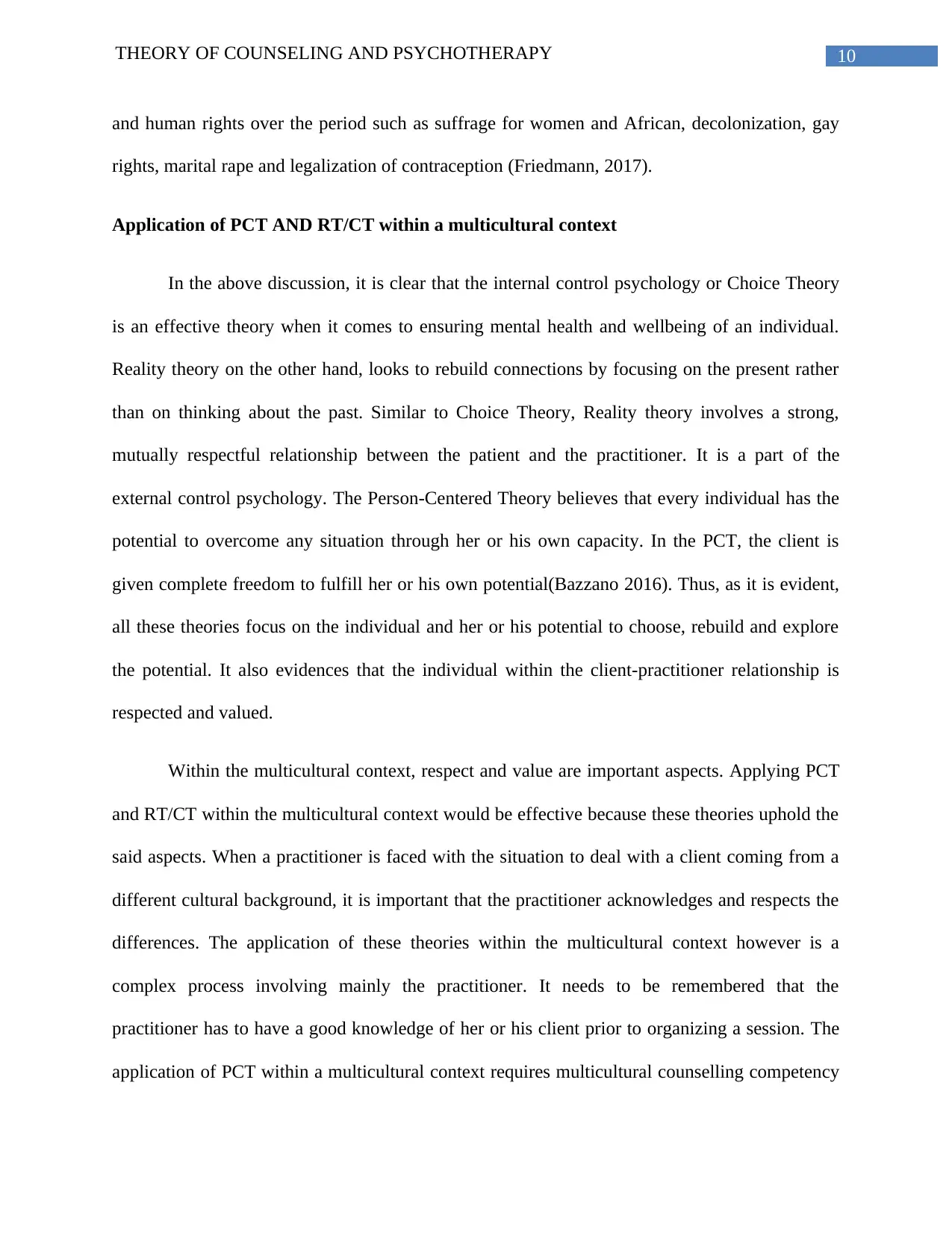
10THEORY OF COUNSELING AND PSYCHOTHERAPY
and human rights over the period such as suffrage for women and African, decolonization, gay
rights, marital rape and legalization of contraception (Friedmann, 2017).
Application of PCT AND RT/CT within a multicultural context
In the above discussion, it is clear that the internal control psychology or Choice Theory
is an effective theory when it comes to ensuring mental health and wellbeing of an individual.
Reality theory on the other hand, looks to rebuild connections by focusing on the present rather
than on thinking about the past. Similar to Choice Theory, Reality theory involves a strong,
mutually respectful relationship between the patient and the practitioner. It is a part of the
external control psychology. The Person-Centered Theory believes that every individual has the
potential to overcome any situation through her or his own capacity. In the PCT, the client is
given complete freedom to fulfill her or his own potential(Bazzano 2016). Thus, as it is evident,
all these theories focus on the individual and her or his potential to choose, rebuild and explore
the potential. It also evidences that the individual within the client-practitioner relationship is
respected and valued.
Within the multicultural context, respect and value are important aspects. Applying PCT
and RT/CT within the multicultural context would be effective because these theories uphold the
said aspects. When a practitioner is faced with the situation to deal with a client coming from a
different cultural background, it is important that the practitioner acknowledges and respects the
differences. The application of these theories within the multicultural context however is a
complex process involving mainly the practitioner. It needs to be remembered that the
practitioner has to have a good knowledge of her or his client prior to organizing a session. The
application of PCT within a multicultural context requires multicultural counselling competency
and human rights over the period such as suffrage for women and African, decolonization, gay
rights, marital rape and legalization of contraception (Friedmann, 2017).
Application of PCT AND RT/CT within a multicultural context
In the above discussion, it is clear that the internal control psychology or Choice Theory
is an effective theory when it comes to ensuring mental health and wellbeing of an individual.
Reality theory on the other hand, looks to rebuild connections by focusing on the present rather
than on thinking about the past. Similar to Choice Theory, Reality theory involves a strong,
mutually respectful relationship between the patient and the practitioner. It is a part of the
external control psychology. The Person-Centered Theory believes that every individual has the
potential to overcome any situation through her or his own capacity. In the PCT, the client is
given complete freedom to fulfill her or his own potential(Bazzano 2016). Thus, as it is evident,
all these theories focus on the individual and her or his potential to choose, rebuild and explore
the potential. It also evidences that the individual within the client-practitioner relationship is
respected and valued.
Within the multicultural context, respect and value are important aspects. Applying PCT
and RT/CT within the multicultural context would be effective because these theories uphold the
said aspects. When a practitioner is faced with the situation to deal with a client coming from a
different cultural background, it is important that the practitioner acknowledges and respects the
differences. The application of these theories within the multicultural context however is a
complex process involving mainly the practitioner. It needs to be remembered that the
practitioner has to have a good knowledge of her or his client prior to organizing a session. The
application of PCT within a multicultural context requires multicultural counselling competency
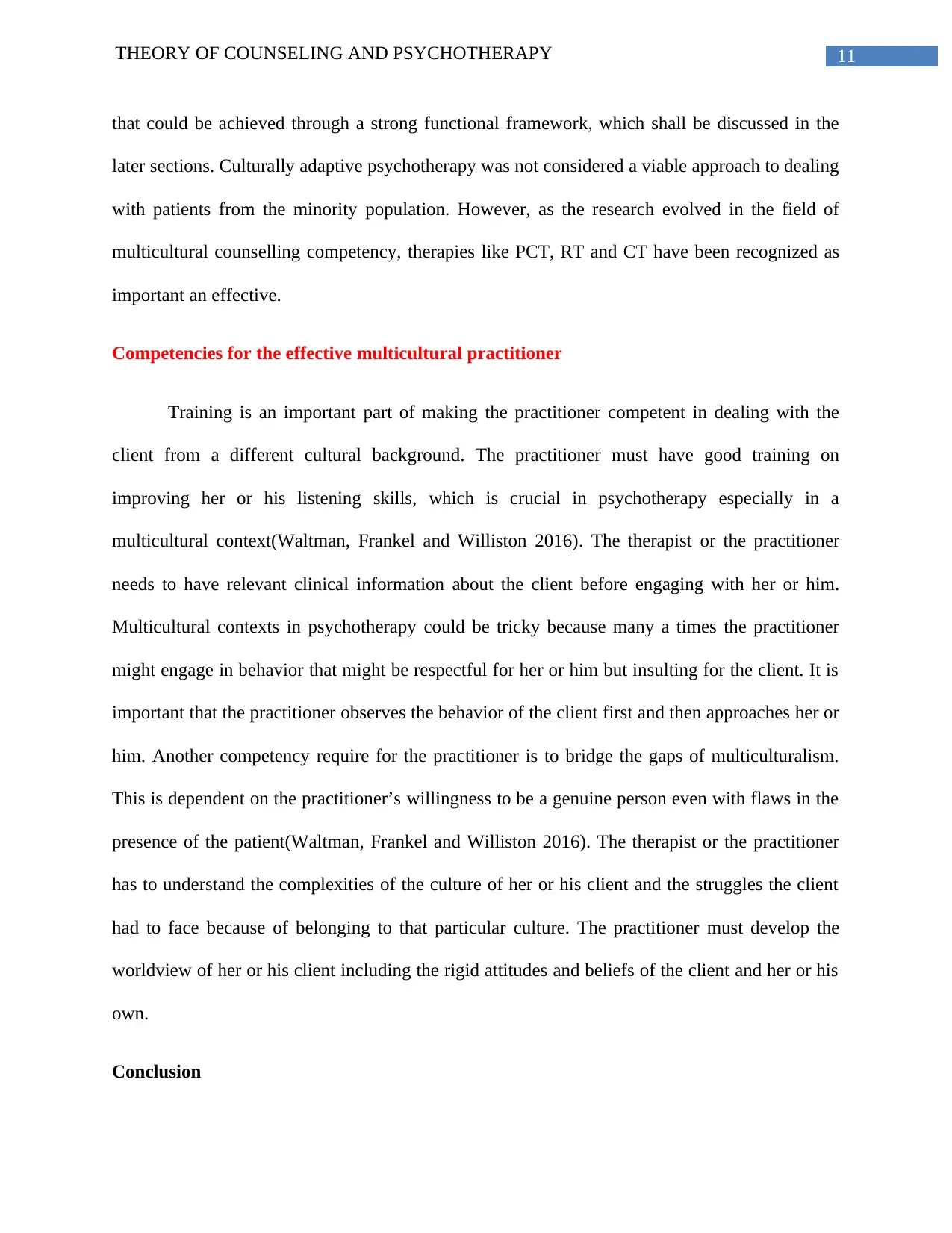
11THEORY OF COUNSELING AND PSYCHOTHERAPY
that could be achieved through a strong functional framework, which shall be discussed in the
later sections. Culturally adaptive psychotherapy was not considered a viable approach to dealing
with patients from the minority population. However, as the research evolved in the field of
multicultural counselling competency, therapies like PCT, RT and CT have been recognized as
important an effective.
Competencies for the effective multicultural practitioner
Training is an important part of making the practitioner competent in dealing with the
client from a different cultural background. The practitioner must have good training on
improving her or his listening skills, which is crucial in psychotherapy especially in a
multicultural context(Waltman, Frankel and Williston 2016). The therapist or the practitioner
needs to have relevant clinical information about the client before engaging with her or him.
Multicultural contexts in psychotherapy could be tricky because many a times the practitioner
might engage in behavior that might be respectful for her or him but insulting for the client. It is
important that the practitioner observes the behavior of the client first and then approaches her or
him. Another competency require for the practitioner is to bridge the gaps of multiculturalism.
This is dependent on the practitioner’s willingness to be a genuine person even with flaws in the
presence of the patient(Waltman, Frankel and Williston 2016). The therapist or the practitioner
has to understand the complexities of the culture of her or his client and the struggles the client
had to face because of belonging to that particular culture. The practitioner must develop the
worldview of her or his client including the rigid attitudes and beliefs of the client and her or his
own.
Conclusion
that could be achieved through a strong functional framework, which shall be discussed in the
later sections. Culturally adaptive psychotherapy was not considered a viable approach to dealing
with patients from the minority population. However, as the research evolved in the field of
multicultural counselling competency, therapies like PCT, RT and CT have been recognized as
important an effective.
Competencies for the effective multicultural practitioner
Training is an important part of making the practitioner competent in dealing with the
client from a different cultural background. The practitioner must have good training on
improving her or his listening skills, which is crucial in psychotherapy especially in a
multicultural context(Waltman, Frankel and Williston 2016). The therapist or the practitioner
needs to have relevant clinical information about the client before engaging with her or him.
Multicultural contexts in psychotherapy could be tricky because many a times the practitioner
might engage in behavior that might be respectful for her or him but insulting for the client. It is
important that the practitioner observes the behavior of the client first and then approaches her or
him. Another competency require for the practitioner is to bridge the gaps of multiculturalism.
This is dependent on the practitioner’s willingness to be a genuine person even with flaws in the
presence of the patient(Waltman, Frankel and Williston 2016). The therapist or the practitioner
has to understand the complexities of the culture of her or his client and the struggles the client
had to face because of belonging to that particular culture. The practitioner must develop the
worldview of her or his client including the rigid attitudes and beliefs of the client and her or his
own.
Conclusion
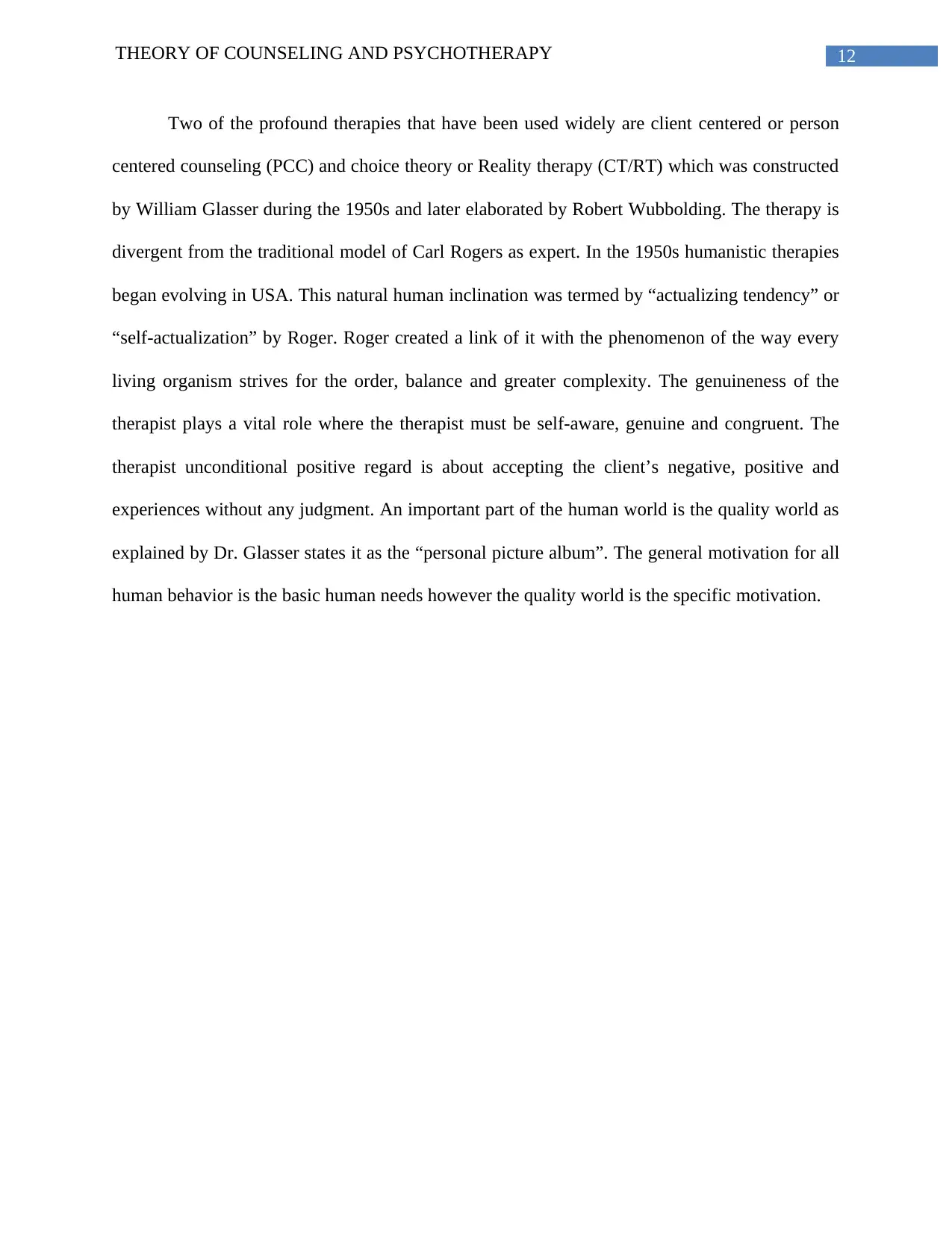
12THEORY OF COUNSELING AND PSYCHOTHERAPY
Two of the profound therapies that have been used widely are client centered or person
centered counseling (PCC) and choice theory or Reality therapy (CT/RT) which was constructed
by William Glasser during the 1950s and later elaborated by Robert Wubbolding. The therapy is
divergent from the traditional model of Carl Rogers as expert. In the 1950s humanistic therapies
began evolving in USA. This natural human inclination was termed by “actualizing tendency” or
“self-actualization” by Roger. Roger created a link of it with the phenomenon of the way every
living organism strives for the order, balance and greater complexity. The genuineness of the
therapist plays a vital role where the therapist must be self-aware, genuine and congruent. The
therapist unconditional positive regard is about accepting the client’s negative, positive and
experiences without any judgment. An important part of the human world is the quality world as
explained by Dr. Glasser states it as the “personal picture album”. The general motivation for all
human behavior is the basic human needs however the quality world is the specific motivation.
Two of the profound therapies that have been used widely are client centered or person
centered counseling (PCC) and choice theory or Reality therapy (CT/RT) which was constructed
by William Glasser during the 1950s and later elaborated by Robert Wubbolding. The therapy is
divergent from the traditional model of Carl Rogers as expert. In the 1950s humanistic therapies
began evolving in USA. This natural human inclination was termed by “actualizing tendency” or
“self-actualization” by Roger. Roger created a link of it with the phenomenon of the way every
living organism strives for the order, balance and greater complexity. The genuineness of the
therapist plays a vital role where the therapist must be self-aware, genuine and congruent. The
therapist unconditional positive regard is about accepting the client’s negative, positive and
experiences without any judgment. An important part of the human world is the quality world as
explained by Dr. Glasser states it as the “personal picture album”. The general motivation for all
human behavior is the basic human needs however the quality world is the specific motivation.
Paraphrase This Document
Need a fresh take? Get an instant paraphrase of this document with our AI Paraphraser
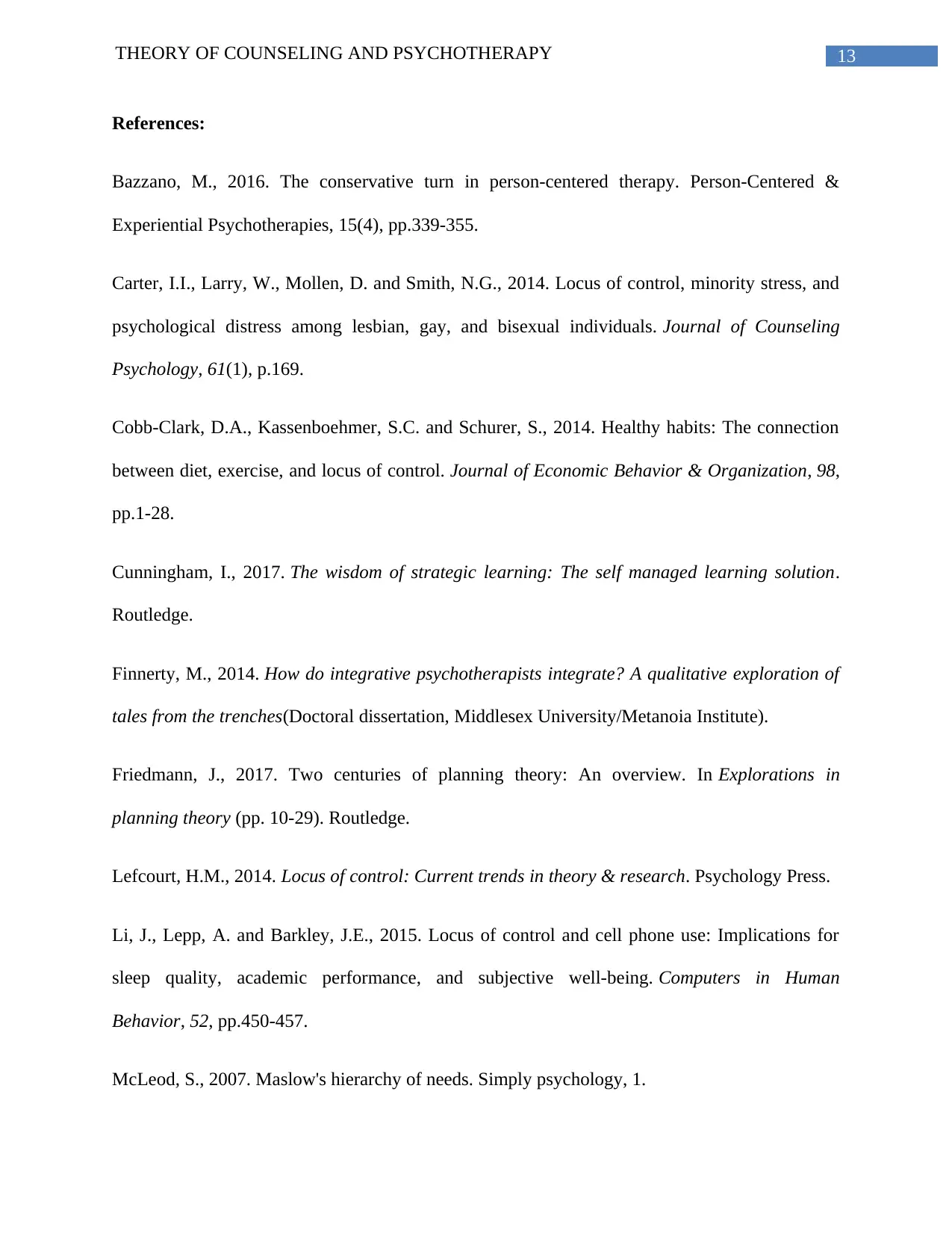
13THEORY OF COUNSELING AND PSYCHOTHERAPY
References:
Bazzano, M., 2016. The conservative turn in person-centered therapy. Person-Centered &
Experiential Psychotherapies, 15(4), pp.339-355.
Carter, I.I., Larry, W., Mollen, D. and Smith, N.G., 2014. Locus of control, minority stress, and
psychological distress among lesbian, gay, and bisexual individuals. Journal of Counseling
Psychology, 61(1), p.169.
Cobb-Clark, D.A., Kassenboehmer, S.C. and Schurer, S., 2014. Healthy habits: The connection
between diet, exercise, and locus of control. Journal of Economic Behavior & Organization, 98,
pp.1-28.
Cunningham, I., 2017. The wisdom of strategic learning: The self managed learning solution.
Routledge.
Finnerty, M., 2014. How do integrative psychotherapists integrate? A qualitative exploration of
tales from the trenches(Doctoral dissertation, Middlesex University/Metanoia Institute).
Friedmann, J., 2017. Two centuries of planning theory: An overview. In Explorations in
planning theory (pp. 10-29). Routledge.
Lefcourt, H.M., 2014. Locus of control: Current trends in theory & research. Psychology Press.
Li, J., Lepp, A. and Barkley, J.E., 2015. Locus of control and cell phone use: Implications for
sleep quality, academic performance, and subjective well-being. Computers in Human
Behavior, 52, pp.450-457.
McLeod, S., 2007. Maslow's hierarchy of needs. Simply psychology, 1.
References:
Bazzano, M., 2016. The conservative turn in person-centered therapy. Person-Centered &
Experiential Psychotherapies, 15(4), pp.339-355.
Carter, I.I., Larry, W., Mollen, D. and Smith, N.G., 2014. Locus of control, minority stress, and
psychological distress among lesbian, gay, and bisexual individuals. Journal of Counseling
Psychology, 61(1), p.169.
Cobb-Clark, D.A., Kassenboehmer, S.C. and Schurer, S., 2014. Healthy habits: The connection
between diet, exercise, and locus of control. Journal of Economic Behavior & Organization, 98,
pp.1-28.
Cunningham, I., 2017. The wisdom of strategic learning: The self managed learning solution.
Routledge.
Finnerty, M., 2014. How do integrative psychotherapists integrate? A qualitative exploration of
tales from the trenches(Doctoral dissertation, Middlesex University/Metanoia Institute).
Friedmann, J., 2017. Two centuries of planning theory: An overview. In Explorations in
planning theory (pp. 10-29). Routledge.
Lefcourt, H.M., 2014. Locus of control: Current trends in theory & research. Psychology Press.
Li, J., Lepp, A. and Barkley, J.E., 2015. Locus of control and cell phone use: Implications for
sleep quality, academic performance, and subjective well-being. Computers in Human
Behavior, 52, pp.450-457.
McLeod, S., 2007. Maslow's hierarchy of needs. Simply psychology, 1.
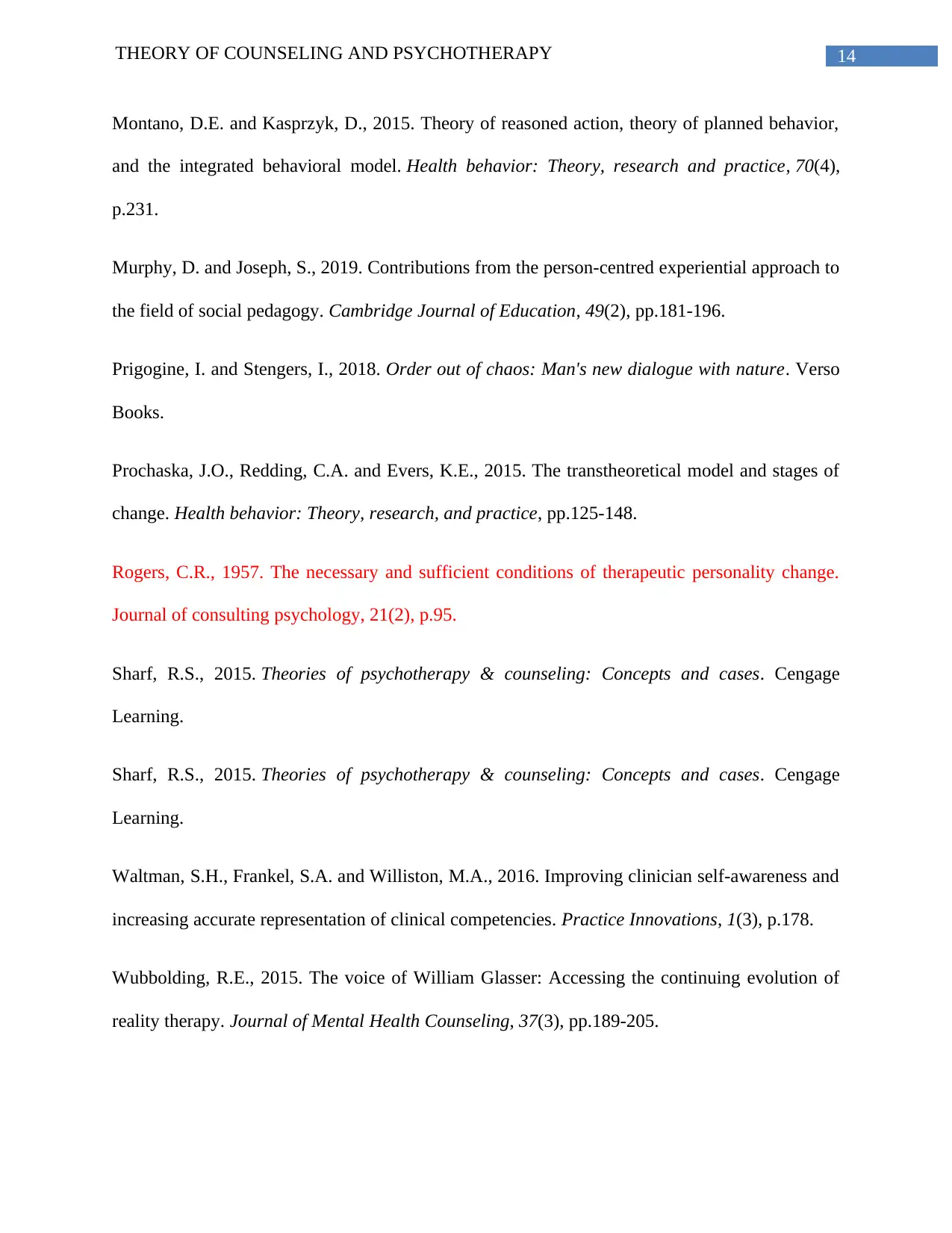
14THEORY OF COUNSELING AND PSYCHOTHERAPY
Montano, D.E. and Kasprzyk, D., 2015. Theory of reasoned action, theory of planned behavior,
and the integrated behavioral model. Health behavior: Theory, research and practice, 70(4),
p.231.
Murphy, D. and Joseph, S., 2019. Contributions from the person-centred experiential approach to
the field of social pedagogy. Cambridge Journal of Education, 49(2), pp.181-196.
Prigogine, I. and Stengers, I., 2018. Order out of chaos: Man's new dialogue with nature. Verso
Books.
Prochaska, J.O., Redding, C.A. and Evers, K.E., 2015. The transtheoretical model and stages of
change. Health behavior: Theory, research, and practice, pp.125-148.
Rogers, C.R., 1957. The necessary and sufficient conditions of therapeutic personality change.
Journal of consulting psychology, 21(2), p.95.
Sharf, R.S., 2015. Theories of psychotherapy & counseling: Concepts and cases. Cengage
Learning.
Sharf, R.S., 2015. Theories of psychotherapy & counseling: Concepts and cases. Cengage
Learning.
Waltman, S.H., Frankel, S.A. and Williston, M.A., 2016. Improving clinician self-awareness and
increasing accurate representation of clinical competencies. Practice Innovations, 1(3), p.178.
Wubbolding, R.E., 2015. The voice of William Glasser: Accessing the continuing evolution of
reality therapy. Journal of Mental Health Counseling, 37(3), pp.189-205.
Montano, D.E. and Kasprzyk, D., 2015. Theory of reasoned action, theory of planned behavior,
and the integrated behavioral model. Health behavior: Theory, research and practice, 70(4),
p.231.
Murphy, D. and Joseph, S., 2019. Contributions from the person-centred experiential approach to
the field of social pedagogy. Cambridge Journal of Education, 49(2), pp.181-196.
Prigogine, I. and Stengers, I., 2018. Order out of chaos: Man's new dialogue with nature. Verso
Books.
Prochaska, J.O., Redding, C.A. and Evers, K.E., 2015. The transtheoretical model and stages of
change. Health behavior: Theory, research, and practice, pp.125-148.
Rogers, C.R., 1957. The necessary and sufficient conditions of therapeutic personality change.
Journal of consulting psychology, 21(2), p.95.
Sharf, R.S., 2015. Theories of psychotherapy & counseling: Concepts and cases. Cengage
Learning.
Sharf, R.S., 2015. Theories of psychotherapy & counseling: Concepts and cases. Cengage
Learning.
Waltman, S.H., Frankel, S.A. and Williston, M.A., 2016. Improving clinician self-awareness and
increasing accurate representation of clinical competencies. Practice Innovations, 1(3), p.178.
Wubbolding, R.E., 2015. The voice of William Glasser: Accessing the continuing evolution of
reality therapy. Journal of Mental Health Counseling, 37(3), pp.189-205.
1 out of 15
Related Documents
Your All-in-One AI-Powered Toolkit for Academic Success.
+13062052269
info@desklib.com
Available 24*7 on WhatsApp / Email
![[object Object]](/_next/static/media/star-bottom.7253800d.svg)
Unlock your academic potential
© 2024 | Zucol Services PVT LTD | All rights reserved.





